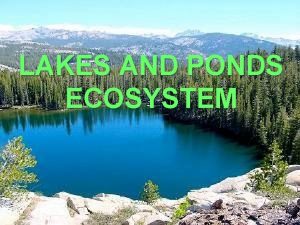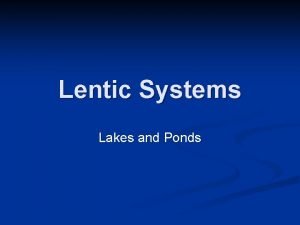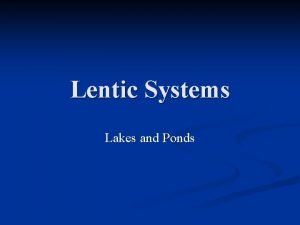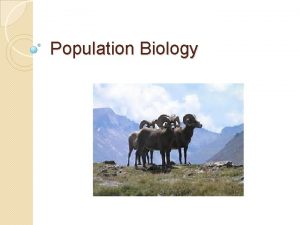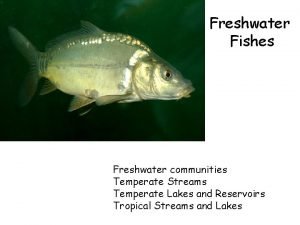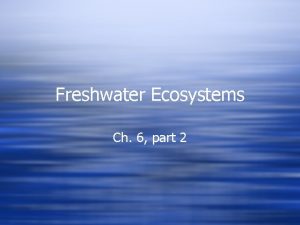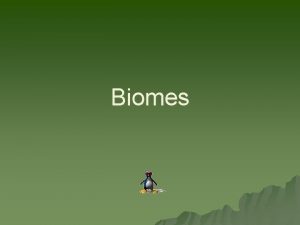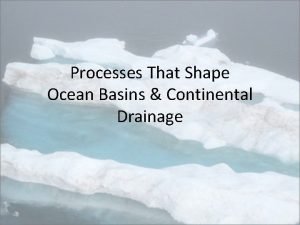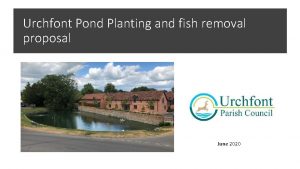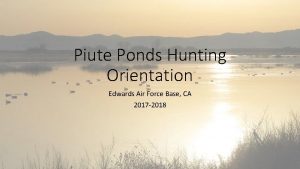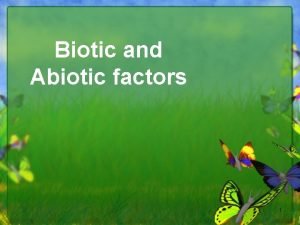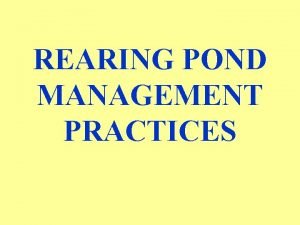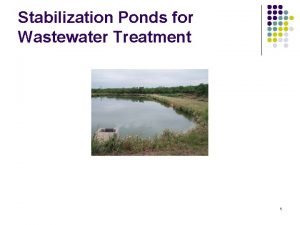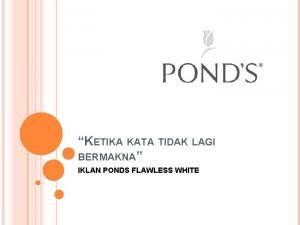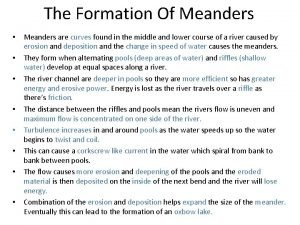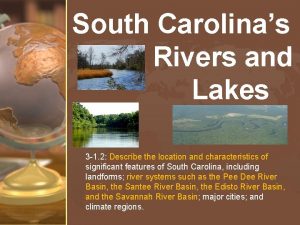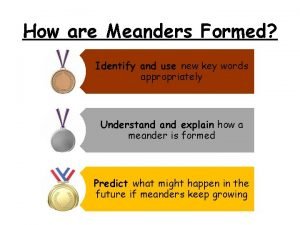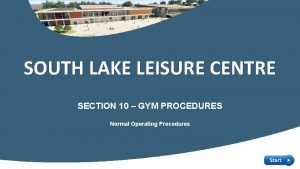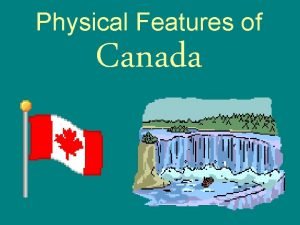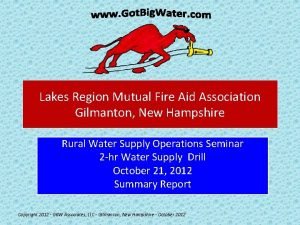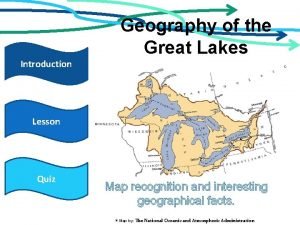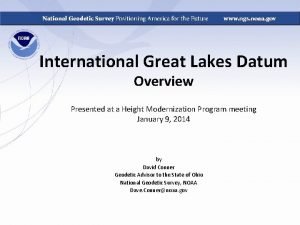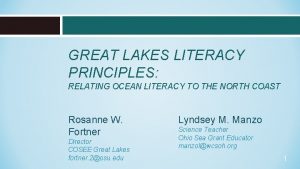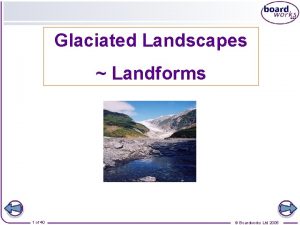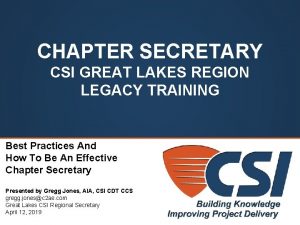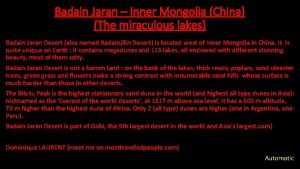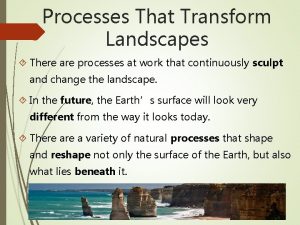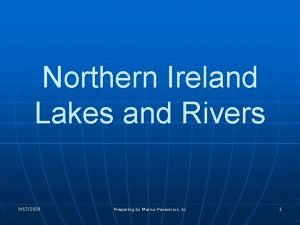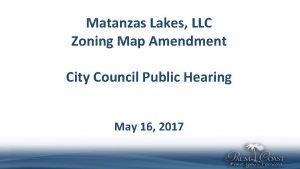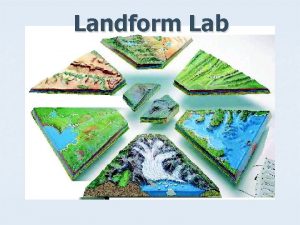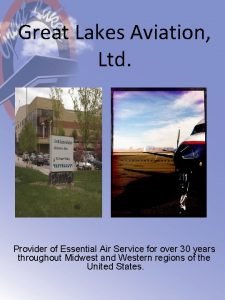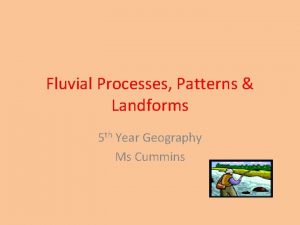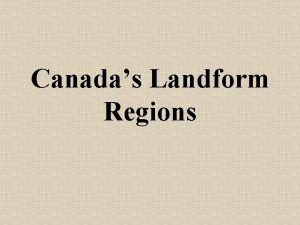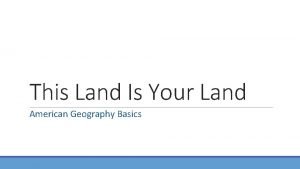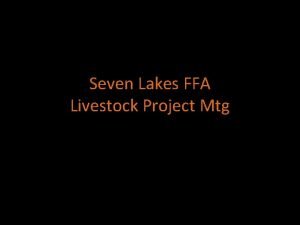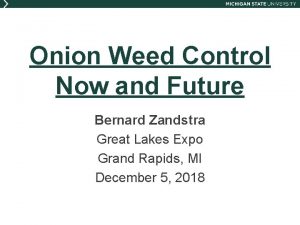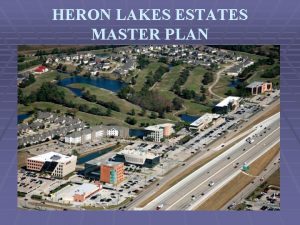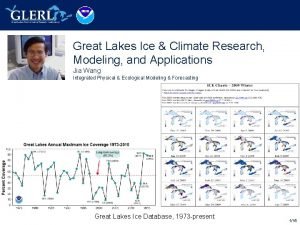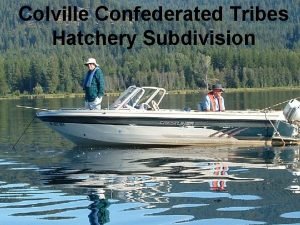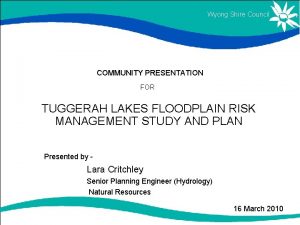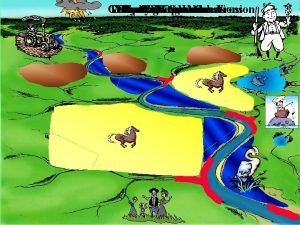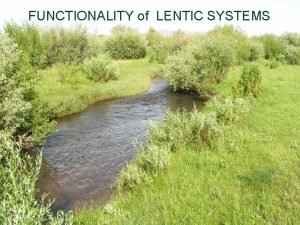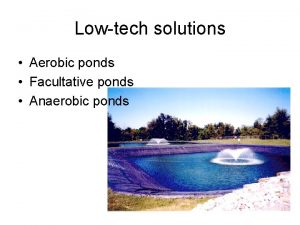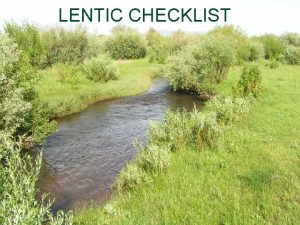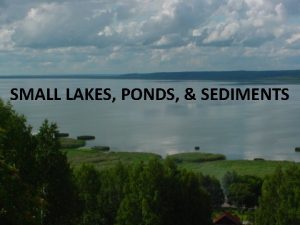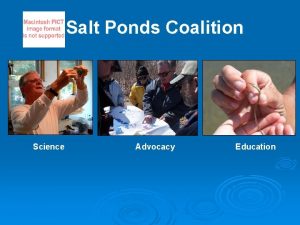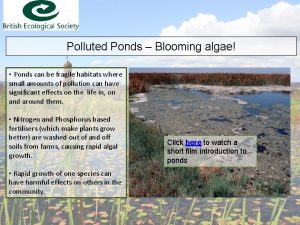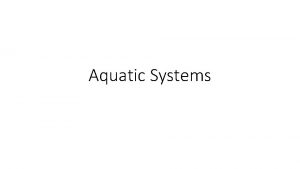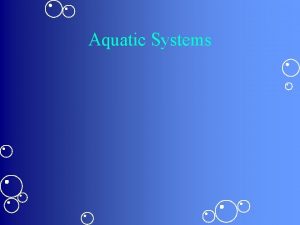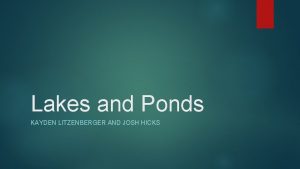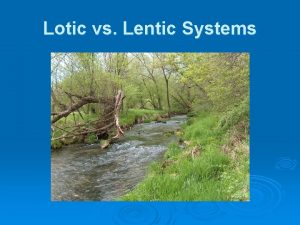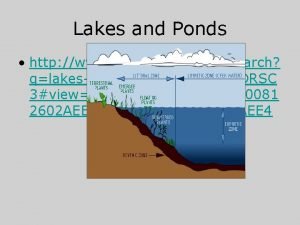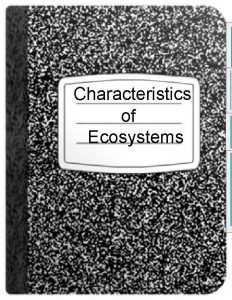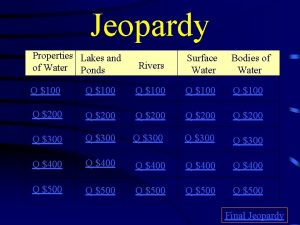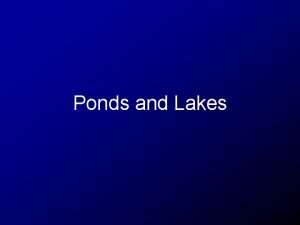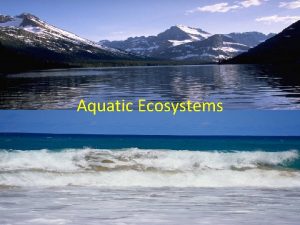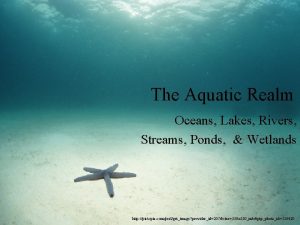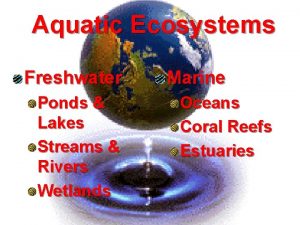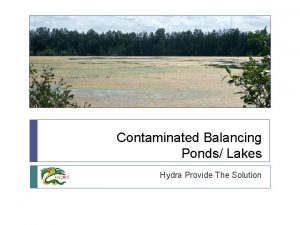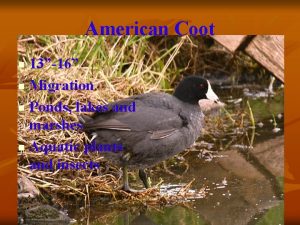Lentic Systems Lakes and Ponds Formation of Lakes







































































- Slides: 71

Lentic Systems Lakes and Ponds

Formation of Lakes Glacier lakes n Oxbow lakes n Playas n Man-made lakes n

Glacier Lakes Carved out by glaciers (glaciation), which fill with water n Northern U. S. and Canada n

How Does Glaciation Work? As the glaciers retreat (melt) they act as scouring pads on the ground underneath them. n Rocks are eroded and mineral deposits become sediments at the bottom of the lake n Some suspended minerals are used by algae for growth, making the water appear green n

The Seven Rila Lakes in Rila, Bulgaria The Great Lakes in northern United States are the largest glacial lakes in the world.

Lake Jokulsarlon, in Iceland

Oxbow Lakes Formed by meandering rivers n Loops of river gets cut off n Lakes are long and narrow, and usually Ushaped n Common in low valleys and flat coastal areas n

Oxbow Lake n Oxbow lake and the Chippewa River in Eau Claire, Wisconsin.

How Does an Oxbow Lake Form? (1) On the inside of the loop, the river travels more slowly leading to deposition of silt.

(2) Meanwhile water on the outside edges tends to flow faster, which erodes the banks making the meander even wider. (3) Over time the loop of the meander widens until the neck vanishes altogether.

(4) Then the meander is removed from the river's current and the horseshoe shaped oxbow lake is formed. Without a current to move the water along, sediment builds up along the banks and fills in the lake.

Texas Oxbow Lakes n Oxbow lakes are commonly formed in the mature segments of Texas rivers. n In the lower Rio Grande Valley, these oxbows are called “Resaca's”.

Playas n Formed from multiple things that leave a depression n n Soil erosion, wind, animal herds Small, shallow, and circular Common in dry plains areas These lakes are ephemeral, and only form at certain times of the year

n Playas are important habitat for migratory birds and waterfowl. The Red-winged Blackbird, Blue-winged Teal, and the Mallard can all be found in playa lakes at some time of the year.

n Sandhill cranes winter in playa lakes

Playa lakes in Kansas agricultural area

Man-Made Lakes n Water reservoirs formed from Damming rivers n Old rock quarries or mines n Stock ponds on farms and ranches n Lake Mead is formed as a result of damming the Colorado River by the Hoover Dam. In Nevada

Zipingpu Dam on the Min River in China

Lentic Habitats n Characterized by The shoreline n The sides of the basin n The surface of the water n The bottom sediments n

Zones of Lentic Habitats n Based on Light Penetration Littoral zone n Limnetic zone n Profundal zone n

Littoral Zone n n n Def. The shallow, well-lighted, warm water close to shore Light can penetrate to the bottom (part of photic zone) Rooted plants can grow (and will also have floating vegetation) Shores have coarse sediments from action of waves Sheltered areas have finer sediments (silt and clay) – plant growth in this zone occurs here Animal life is very diverse n Invertebrates common to lotic habitats


Limnetic Zone Def. Open, well-lit waters away from the shore Lack of rooted plants because light can’t penetrate the bottom n Plankton and fish are common n

Profundal Zone n n n Deep, bottom-water area with no light penetration (aphotic zone) No photosynthetic organisms or rooted plants Sediments are silt and clay mixed with organic matter that settles to the bottom n n n An area of decomposition where detritus (dead organic matter that drifts from above) is broken down Organisms living here are tolerant of little or no light or oxygen. Nutrients are plentiful because of decomposition


Benthic Zone n Refers to the floor itself…we’ll look at this when we examine organisms at this level

Biological Productivity The amount of plankton, algae, aquatic macroinvertebrates and fish that a body of water can produce and sustain n Usually limited to the depth of light penetration n n Light penetration is limited by color of the water and amount of suspended solids

Ponds vs. Lakes Pond = body of water where light penetrates all the way to the bottom n Lake = depth of light penetration varies from several inches to several feet n

Determining the Trophic State n Total Plant Nutrients Phosphorous and nitrogen are needed for plant growth and maintenance n Certain level is needed (too much or too little is not a good thing) n If nutrients are too high, algae blooms occur n n Increase the turbidity of the water n Decrease the oxygen levels

n Chlorophyll a Measure of the algae population n Influenced by the amount of nutrients n n Water Clarity (turbidity) Water clarity determines how far light can penetrate n Phytoplankton and plants need light to grow, so won’t grow if light is limited n Algae blooms cause lower water clarity n

Ecological Succession in Lakes

Ecological Succession Ecological succession is the progression of an ecosystem from one form to another n It includes a natural aging process of a lake n Lakes and ponds evolve differently then rivers n

n n n Over time, sediments become higher on the floor of ponds and lakes and build up. The shallower the lake becomes, the further light can penetrate, so more plants grow on the bottom. Water tolerant plants and shrubs move in. Marshes, swamps, and bogs are usually the mature stage of a lake. Finally, a meadow completes the succession stages If left undisturbed, grasses and shrubs will be replaced by larger trees and forests.

Biological Productivity

Characteristics of Biological Productivity n 4 categories of lake classification based on biological productivity (amount of organic matter)…stages of succession Oligotrophic n Mesotrophic n Eutrophic n Hypereutrophic n

Oligotrophic Lakes n n n n Def. deep, nutrient-poor lakes in which plankton is not very productive Nutrient level and productivity is low Water is usually clear Low aquatic plants and plankton Few fish High oxygen content because of little detritus from limnetic zone Sandy bottoms with little organic material May turn into eutrophic lake over time (if runoff brings in excess nutrients or fertilizers)


Mesotrophic Lakes Nutrients and productivity is moderate n Some aquatic plants n Water clarity is becoming somewhat cloudy n

n Littoral habitat in a mesotrophic lake

Eutrophic Lakes n n n Def. Shallow, nutrient-rich lakes with very productive plankton Nutrient level and productivity is high Large populations of algae, plankton, fish, plants, and macroinvertebrates Frequent plankton blooms Sediments with high organic matter Water is commonly colored


Hypereutrophic Nutrient levels and productivity are very high n Large populations of aquatic plants and animals n Frequent plankton blooms n Sediments with most organic matter n

Temperature Stratification and Turnovers

Ponds and Shallow Lakes Temperature and dissolved oxygen remains about the same from top to bottom n Water is easily mixed by the wind n Photosynthesis and plant growth can occur from top to bottom (since light can penetrate all the way down) n

Deep Lakes Water temperature and dissolved oxygen levels can remain same from top to bottom layers in the winter n During warm summer months, layers form n The surface if warmed up by the sun n Denser, colder water remains below it n Doesn’t get mixed by the wind n

Fall Turnover

Effects of Turnovers Mixing of once layered water returns oxygen levels to the deep areas. n Areas in the south have one turnover per year in the fall. n In the north, lakes become stratified in the summer and the winter (because ice forms on the surface, causing inverse stratification). Thus, there are two turnovers (fall and spring). n


Stratification Zones n During summer months increased sunlight and warm winds heat the surface water trapping colder water on the bottom. n Differences in the densities of warm and cold water resist mixing by wind n Stratification creates three different zones: n Epilimnion n Metalimnion n Hypolimnion

Zones of Stratification n Three distinct layers form in deep lakes during the summer months: Epilimnion n Metalimnion n Hypolimnion n

Epilimnion n n n Warmest zone near the surface Circulates freely with varying temperatures according to location on the globe Wind and currents mix surface water Most organisms found in this layer Area of greatest productivity Greatest light penetration Greatest oxygen content

Metalimnion Middle layer n Steep declines in temperature (area of thermocline) n Temp. decreases 1 o. C per meter of depth n

Hypolimnion n n n Third layer Deep and cold with little to no temperature change Low oxygen due to few or no plants Little to no mixing by wind Bottom-dwelling organisms and bacteria feed on organic matter and further deplete the oxygen Little or no light penetration

Lets Review

n What is an example of a lotic system?

n What is an example of a lentic system?

n The Littoral, Limnetic, Profundal, and Benthic zones are all categorized based on what?

n Oligotrophic and eutrophic lakes are classified according to what?

n Name one example of a habitat that can be found in a flowing river.

n Name one example of a habitat that can be found in a lake.

n Where is the water going from and coming to in a gaining stream?

n Where is the water coming from and going to in a losing stream?

n What two factors are most important in creating an oxbow lake from a meandering river?

n What is the difference between a riffle and a run?

n Stratification in lakes in the south occurs when?

n When do turnovers occur in northern lakes that freeze over?

n What is the riparian zone?

n What process forms sand bars?

n The three types of streams (ephemeral, perennial, and intermittent) are categorized based on what?

n The epilimnion, metalimnion, and hypolimnion zones are categorized based on what?

n Depositional and Erosional zones in lotic systems are based on what? n The rate of the water flow
 Littoral limnetic and profundal zones
Littoral limnetic and profundal zones Lentic system
Lentic system Lentic zone
Lentic zone Population biology definition
Population biology definition -is an example of a lentic ecosystem.
-is an example of a lentic ecosystem. Lentic ecosystem
Lentic ecosystem Lentic ecosystem
Lentic ecosystem Finger lakes formation
Finger lakes formation Kettle lakes formation
Kettle lakes formation Fish nursery management practice
Fish nursery management practice Do you think katniss' anger towards her mother is justified
Do you think katniss' anger towards her mother is justified Coir rolls for ponds
Coir rolls for ponds Piute ponds
Piute ponds Plant
Plant The great ponds
The great ponds Aerobic ponds
Aerobic ponds Stocking pond management
Stocking pond management Oxidation ponds
Oxidation ponds Iklan ponds
Iklan ponds Formation initiale vs formation continue
Formation initiale vs formation continue Decision support systems and intelligent systems
Decision support systems and intelligent systems The formation of meanders
The formation of meanders South carolina rivers and lakes
South carolina rivers and lakes How are meanders created
How are meanders created Principles of complex systems for systems engineering
Principles of complex systems for systems engineering Embedded systems vs cyber physical systems
Embedded systems vs cyber physical systems Engineering elegant systems: theory of systems engineering
Engineering elegant systems: theory of systems engineering Great lakes scrip
Great lakes scrip Great lakes depth comparison
Great lakes depth comparison Luke luck likes lakes
Luke luck likes lakes South lake membership
South lake membership Physical characteristics of canada
Physical characteristics of canada Pegword
Pegword Sandia lakes
Sandia lakes Lakes region mutual fire aid
Lakes region mutual fire aid Lakes in hungary
Lakes in hungary Brenntag lachine
Brenntag lachine The great lakes quiz
The great lakes quiz International great lakes datum
International great lakes datum Great lakes literacy principles
Great lakes literacy principles Drumlin
Drumlin Csi great lakes region
Csi great lakes region Twin lakes mongolia
Twin lakes mongolia Oligotrophic vs eutrophic lakes
Oligotrophic vs eutrophic lakes Slam academy uniforms
Slam academy uniforms The disco finger
The disco finger Great lakes labs
Great lakes labs Transforms eroded parts of earth's surface into lakes
Transforms eroded parts of earth's surface into lakes Northern ireland lakes
Northern ireland lakes Kawartha lakes zoning map
Kawartha lakes zoning map Are floods constructive or destructive
Are floods constructive or destructive Blue lakes aviation
Blue lakes aviation Oxbow lake definition
Oxbow lake definition Palm beach lakes church of christ
Palm beach lakes church of christ Western cordillera activities
Western cordillera activities Ixl pblhs
Ixl pblhs Great lakes on us map
Great lakes on us map Blue lakes aviation
Blue lakes aviation Seven lakes ffa
Seven lakes ffa Pompton lakes school district nj
Pompton lakes school district nj Onion weed in lakes
Onion weed in lakes Indian creek lakes course
Indian creek lakes course Heron lakes golf course houston
Heron lakes golf course houston Product design planning
Product design planning 5 great lakes
5 great lakes The great lakes
The great lakes Twin lakes subdivision
Twin lakes subdivision South lakes leisure centre directions
South lakes leisure centre directions Flooding tuggerah lakes
Flooding tuggerah lakes Toshka lakes
Toshka lakes Luke 2:40
Luke 2:40 Arsnsl
Arsnsl
